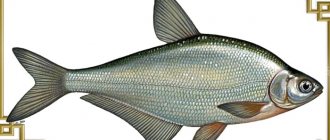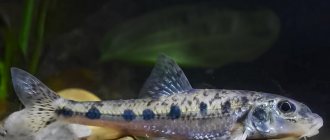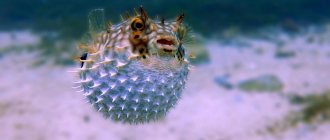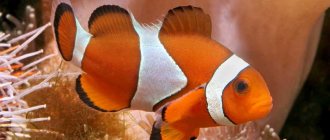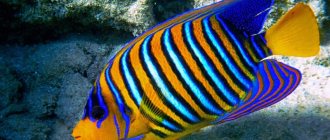- two neighboring fish funnyly spit sand from their holes at each other. Whether they're digging up an opponent's hole or just natural enmity, who knows, but it looks interesting
If you find an error, please select a piece of text and press Ctrl+Enter.
News
- 23:41 The Kyrgyz Republic and Tajikistan agreed on measures to resolve the border conflict - video
- 21:04 There will be no light on sections of 36 streets in Bishkek - schedule for February 26
- 20:39 Due to coronavirus, a thousand tourists were isolated in a hotel in the Canary Islands - media
- 20:22 Ramzan Kadyrov challenged Alexander Emelianenko to a fight - sparring took place
- 20:04 Where is the 45 million soms contributed by the investor for the logistics center in At-Bashi
All news
Within a few days of publication, the video received several thousand views.
A video of two fish arguing in an aquarium has gone viral on Facebook.
Within a few days of publication, the video received several thousand views.
In the video, two neighboring fish take turns hiding in holes and throwing sand from the aquarium at each other. It is unknown how the quarrel between the aquarium inhabitants ended, since the video ends at the next throw-lunge from the neighbor.
On this topic
More video
A saleswoman fought off an armed robber with a mop. Video
A saleswoman in a village in Poland used a mop to fight off a robber who burst into the store with a pistol.
Main topics
The project of a trade and logistics center in the At-Bashi district was closed due to dissatisfaction of local residents. Meanwhile, the investor transferred millions to compensate for agricultural losses.
Tajikistan and Kyrgyzstan agreed on joint measures to resolve the border conflict for 2021. At the meeting in Batken, the parties agreed to continue joint work on demarcation and delimitation of the border.
More than 500 people in the republic are under medical supervision; there are no confirmed cases of coronavirus infection.
Friends from Pisces are loyal, responsive and very emotional! They are like a coloring book with lively, moving pictures that can be given the color you need. That's why making friends with these people is so easy and pleasant.
Bryzgun taught a man how to splash correctly...
Author Anton Evseev
01.11.2012 15:00
Science » Ecology » Nature
Recently, zoologists from Italy unraveled the secret of the splasher. They figured out how this small fish can spit water as much as two meters and knock down insects that hold tightly to the leaves with a stream of water. It turned out that the issue here is not at all a matter of muscle effort, which creates greater impact power. It’s just that the splasher knows the laws of physics quite well...
Splashers are freshwater fish from the Toxotidae family that live in shallow waters of rivers and lakes in India, Australia, Polynesia, and the Philippines. They received this nickname for their original way of hunting ground insects. Seeing prey sitting on a leaf, the fish, assessing the distance and taking aim, releases a stream of water, which knocks the prey into the water. There the successful hunter picks it up and starts eating.
The mechanism by which the “shot” is carried out is quite simple for the spray guns. Before the “shooting” begins, the fish freezes at the surface of the water directly under the victim upside down. Afterwards, the hunter, with a sharp movement of the gill covers, directs water along the longitudinal groove on the palate in a thin stream or individual drops, depending on the position of the movable tip of the tongue. Observations have shown that the volume of “shot” water always depends on the size of the prey - a larger “rain” falls on a larger insect and vice versa.
Interestingly, splashers are distinguished by fantastic accuracy - they always hit their target and never miss. At the same time, the distance at which a shot can be fired sometimes reaches one and a half to two meters! It should be noted that such a powerful stream of water is released by a fish whose size is only 5-10 centimeters. Where does the splasher get the strength to form such a powerful jet of water?
Splasher fish
The splasher fish (also known as the sniper fish) feeds in a unique way: with a stream of water from its mouth it knocks down insects perched on the leaves above the surface of the reservoir. The scientific name of the species belonging to the Perch-like family, described by the German scientist Pallas, is the striped splasher (in Latin Toxotes jaculatrix). The word Toxotes means "archer" and Jaculatrix translates to "thrower". Although the jumping fish is unpretentious, it is suitable for an experienced aquarist, as there are some nuances in its maintenance.
Description
In its natural environment, the spray fish reaches 30 cm in length. But aquarium specimens rarely grow more than 18 cm. In the external description of the species, the most notable thing is the shape of the body: flattened, from the side it resembles a beveled tree leaf.
External characteristics of the type:
- The eyes are large;
- The front part of the head is elongated;
- The location of the dorsal and anal fins is typical for fish living in the surface layer of water - close to the tail;
- The color is modest, intended for camouflage in mangrove swamps, the main color is olive with a silvery tint, the sides are decorated with dark rounded and elongated spots.
The weapon used to attack insects is the mouth, which has a special jaw structure. A groove runs along the palatal area. The fish has a thin and long tongue; it closes the furrow, forming a hollow tube with a diameter of no more than 0.1 mm. The remaining free movable tip of the tongue acts as a shutter that opens and closes the tube.
Description of the hunting process: upon seeing the prey, the fish sharply slams its gill covers, creating pressure for a stream of water rushing into the tube. Water flies out of the mouth, and the sprayer, using the shutter tongue, controls the thickness of the jet and the frequency of shots. The speed and force of the shot are such that the insect does not have time to react, and thus ends up falling into a pond and being swallowed up by a predator. The range of spitting water is up to 1.5 m, although large individuals can shoot up to 3 m.
Content
The aquarium spray fish is not capricious in care and maintenance; both an aquarium and a paludarium are suitable for it. If you want the fish to reveal its hunting abilities, then you should create conditions close to natural ones and select a spacious tank. The optimal volume of the aquarium is 200 liters.
There is a nuance in arranging a tank for a splasher: fish often jump out of the water, grabbing food, they can fall to the floor, and if you use an aquarium lid, they can hit it. Therefore, the best option is a high open tank with a low water level.
Water parameters
Comfortable water parameters for jumping fish:
- Temperature – 25-27°C;
- Hardness – 10-18 dGH;
- Acidity – 7-8 pH.
The water must remain clean from decay products of organic matter and saturated with air, so a good filtration system is necessary. A third of the fluid volume needs to be changed weekly.
The striped splasher easily adapts to living in fresh water, but this option is not suitable for permanent keeping. Brackish water is healthier for fish, so salt is added to it, 3 teaspoons per 10 liters.
Vegetation
The abundance of underwater plants should be moderate. Broad-leaved species that are not susceptible to salt dissolved in water are preferred.
Swamp vegetation with long hanging leaves is planted above the water. The fish will shoot at insects landing on the leaves. When creating a swamp aquarium ecosystem, using a tank lid is a must. It will create a microclimate suitable for plants and prevent insects from flying out of the aquarium.
Lighting
For jumping fish, low-intensity, dim lighting is comfortable.
Decor
You should put a lot of driftwood at the bottom. This will be an imitation of mangrove roots.
Priming
Since the archer fish lives in the upper layer of water, any soil can be used: it is not important for the fish.
Breeding and reproduction
Breeding the squirrel at home is not possible. In nature, fish go to sea to spawn. The female lays about 3 thousand eggs and leaves them floating on the surface of the water.
Sex differences
In the splasher, sexual differences are not pronounced. There is no way to determine sex, so fish on farms are kept in large schools to ensure that the breeding process occurs.
For commercial purposes, the squirrel is bred on farms. The fry are fed flakes and small insects.
Habitat in nature
The range of the striped splasher covers the south-east Asian regions and northern Australia. The fish is able to live in fresh water, but prefers slightly salty water. The natural environment is brackish mangroves, but sometimes fish swim out to the reefs.
When living in nature, splashers, carried with the current in a stationary vertical position, look out for potential victims - insects, larvae and even small fish.
Residents of Indonesia catch jumpers for food. Fish meat is edible and pleasant to the taste.
Spray fish: description, content, breeding, photo, video
The striped splasher fish (lat. Toxotes jaculatrix) can live in both fresh and brackish water.
Muckers are very common in both Asia and northern Australia. They primarily live in brackish mangrove swamps, where they spend their time standing with the current and looking for food. Singles can swim into the reef strip.
The squirrel differs in that it has developed the ability to spit a thin stream of water at insects that sit on plants above the water.
The force of the impact is such that the insects fall into the water, where they are quickly eaten. It seems that the splashers have an unerring knowledge of where the victim will fall and quickly rush there before it is intercepted by others or carried away by the current.
In addition, they are able to jump out of the water to grab the victim, however, not high, to the length of the body. In addition to insects, they also eat small fish and a variety of larvae.
Description
The archer fish has a flat body with a triangular head. In nature it grows up to 25 cm in length, aquarium specimens are shorter. The color of the fish is not particularly remarkable - mainly steel or whitish with several transverse black stripes. The fins of the splasher fish are shifted towards the tail. Fish are endowed with binocular vision, which helps them accurately focus on the victim and hit their weapon exactly on target. They spit out water spray through a thin groove located in the sky. The tongue serves as a bowstring. In artificially created reservoirs, the spray fish lives for about 10 years.
Habitat in nature
The habitat of the arrow fish is Southeast Asia, Indonesia and Australia. Found in mangroves and estuaries along the tropical coasts of the Indian and Pacific oceans. The fish spend most of their time hunting, hanging in the upper water layers. Sticking their heads out, individuals wait for prey. Local residents catch them for food; they say that the fish’s meat is very tasty.
Splashfish use the laws of physics to spit.
Rice. 1.
Spread of the water jet ejected by the striped splasher
Toxotes jaculatrix.
(
A
–
C
) — Acceleration phase.
( D
–
E
) — Almost ballistic phase.
F
- Impact of the jet on the insect.
G
- The size of the head of the jet gradually increases during the flight;
the dotted line
indicates the jet's flight path.
H
- Various jet flight trajectories.
I
— Interpolation of the head of the jet with an ellipsoid;
top row
- projections of the head of the jet,
middle row
- elongated ellipsoids,
bottom row
- overlay of projections and ellipsoids.
J
— Distribution of spitting angle values.
Image from the discussed article in PLOS ONE
Shooting fish have long amazed scientists with their amazing ability to hunt insects, knocking them off surface vegetation with a strong stream of water. Until today, it was believed that fish could spit so strongly thanks to the internal, hitherto undescribed, structures of the splasher itself. But Italian experts, having carried out a kinematic analysis of the water jet, showed that the splasher does not require any special structures. The fish simply skillfully applies the laws of hydrodynamics, using the unstable properties of the jet, which, by the way, is reminiscent of the mechanism of an inkjet printer.
Splashfish living in mangrove swamps have developed a unique way of hunting insects. As soon as they notice their prey sitting on a leaf above the water, they accurately spit at it with a strong stream of water and knock down the insect, which falls into the water and is safely eaten. Since the description of the remarkable method of hunting of the splashers (and it was described a very long time ago - in 1764), scientists have puzzled a lot over the mechanism by which the fish can spit so much. The scientists looked for any internal structures similar to those known in chameleons and salamanders, in which muscle energy is slowly stored in collagen fibers and then quickly released, causing the tongue to shoot out at an acceleration of 500 m/s2. But no morphological structures similar to the described catapult mechanism in the chameleon were found in the squirrels.
To understand this mechanism, physicists from the University of Milan filmed the hunting process of the striped squirrel Toxotes jaculatrix
on an ultra-high-speed video camera (it’s even scary to imagine - 1000 frames per second!), after which they carried out a kinematic analysis of the video frames. The analysis yielded surprising results. It turns out that the splasher does not need a special internal spitting mechanism at all, the fish simply change the speed and acceleration of the liquid they spit out and skillfully use the laws of hydrodynamics.
The study involved two similar-sized squirrels (67 and 61 mm long) placed in a flat aquarium and forced to spit through a frame with a narrow slit. This was done to ensure that the fish was always positioned in profile to the video camera (as in Fig. 1). Only in this case was it possible to obtain photographs of the jet from a constant angle. It turned out that the jet flies out of the mouth of the sprayer with acceleration (Fig. 1, A–C; Fig. 2, A–B), and then flies almost along a ballistic trajectory (Fig. 1, D–E), that is, mainly under by the force of gravity and the force of aerodynamic air resistance. A large head part and a thin “tail” could be distinguished in the jet, and the head part gradually increased during the flight (Fig. 1, G, I). Over the range of distances over which the fish spit (97–153 mm), the trajectory of the jet was comparable to linear, regardless of the spitting angle (Fig. 1, H). But the fish still showed a preferred angular sector of 70 to 80 degrees (Fig. 1, J), under which they most often spat.
The authors tried to understand in detail what happens in the first 10–15 ms of spitting. A stream of water flies out of the mouth of the fish at a relatively low speed of 2 m/s and with a strong acceleration of 200–400 m/s2 (Fig. 2, A–C). Within 15 ms the acceleration drops to zero. The initial acceleration of the head of the jet leads to a speed of about 4 m/s. It is noteworthy that the size of the head part gradually increases (Fig. 2, C), which indicates a higher speed of the tail than the head part of the jet. The head part increases due to the fact that liquid passes there from the tail. Why is this happening? The authors claim that this happens simply because the fish itself changes the speed of the liquid it spits out, gradually increasing it.
Rice. 2.
Kinematics of the head of the jet.
Changes in speed ( A
), acceleration (
B
), size (
C
) and longitudinal length (
D
) of the head part with time.
Different colors
correspond to different flight paths shown in Fig.
1, H. Image from the discussed article in PLOS ONE
The authors calculated how the force of the head of the jet changes during flight and what it is at the moment it hits the insect, using Newton’s well-known second law. They, of course, made some assumptions: according to calculations, the victim should be motionless, its surface should be completely wetted, and there should be no reflection from the insect. As a result, they received a gradually increasing force (Fig. 3, A), which at the moment of impact reaches an average of 200 millinewtons. An average insect (such as a fly or bedbug) weighing about 100 mg typically clings to a leaf with a force of about 20 mN. Thus, the force of the jet upon impact is almost an order of magnitude greater than the force with which the prey grabs the substrate, which explains the ease with which the insect is knocked down.
In addition, physicists calculated the power carried by the head of the jet. At the moment of spitting, the power per unit of mass is very small, because the muscles themselves that are involved in spitting are very small (only 178 mg in one fish and 135 mg in another). However, the power increases greatly during the flight, reaching values of 2950 and 2820 W/kg during impact in the first and second fish, respectively (Fig. 3, D). It turned out that these figures are significantly higher than those known for the muscles of other vertebrates (about 500 W/kg).
Rice. 3
.
The strength and power of the head of the jet. A
- Time
evolution
(see time evolution) of the jet force at the moment of impact.
The pink area
represents the range of forces with which different insects cling to the substrate.
B
- Temporal
evolution
of the specific power required for the muscles involved in spitting, assuming that there is no amplifying hydrodynamic mechanism.
C
— Temporal
evolution
of the specific power instantly transmitted by the muscles of the spray gun at the head of the jet.
The horizontal dotted line
in (
B
) and (
C
) corresponds to the 500 W/kg value shown for vertebrate muscle.
Different colors
correspond to different flight paths shown in Fig.
1, H. D
- Distribution of specific power upon impact at spray gun No. 1.
E
- The movement of the jet section is shown during three recording moments, separated by a time interval ∆t.
The acceleration of the liquid at the moment of exit from the nozzle (=spitting moment) determines the speed of propagation of the jet in its front part ( u)
and the speed in the tail part
(u+∆u)
.
The difference in speeds ∆u
determines the compression of the section in length and, conversely, the increase in its radius.
Image from the discussed article in PLOS ONE
The authors also calculated the power of the jet that the muscles would have to develop when spitting in order to give the jet the necessary acceleration shown in Fig. 2, B. If we assume that we do not have an amplifying hydrodynamic mechanism, but there is an internal mechanism similar to the catapult mechanism of a chameleon, then the change in power developed by the muscles would correspond to the graph in Fig. 3, B. However, in reality, the muscle power of the squirrel fluctuates significantly below the level of 500 W/kg (Fig. 3, C). These results are in excellent agreement with the lack of an internal reinforcing mechanism in the muskellunge. They confirm that power is gradually transferred from the muscles to the tail of the jet, and then to its head, which leads to a slow accumulation of energy in the external environment.
The authors draw an interesting analogy between the jet of a spray gun and the pulsating jet of an ink, or inkjet, printer. The operating principle of an inkjet printer is shown in Fig. 3, E. At the moment of the initial acceleration phase, the speed u
in the front part of the jet there is less than in the tail part. Therefore, during the flight of the jet, the front and rear “ends” come closer and the length of the cylindrical section decreases. Since the mass and driving force of the cylindrical section remain constant, its radius increases. Thus, as a result, we have a thin and wide cylindrical section perpendicular to the axis of the jet. We see a very similar picture in the stream of water spat out by the splashers. Without saying a word, both man and nature use the same physical laws.
Genus name Toxotes
means "archer" in Greek. The authors emphasize that this is an extremely correct name. The archer uses external force to draw back the bowstring, thereby storing energy in the bow's bent arc. Muckers also use an external mechanism to enhance muscle strength, although based on a different principle. The remarkable thing is that these fish did not create special internal devices, but simply used the existing laws of physics.
Source:
Alberto Vailati, Luca Zinnato, Roberto Cerbino.
How archer fish achieve a powerful impact: hydrodynamic instability of a pulsed jet in Toxotes jaculatrix
//
PLOS ONE
. 2012. 7(10): e47867.
Varvara Vedenina
Keeping splashers in the aquarium
Often, splashers are kept in aquariums to create the so-called wow effect for spectators watching these fish hunt.
To demonstrate the abilities of the splasher, an insect (for example, a cricket) is planted on a plant near the surface of the water and waits. As a rule, to the general admiration of the public, shots follow immediately and soon the prey is in the mouth of the most nimble specimen.
It is not difficult to keep these fish in an aquarium, especially if you create an environment close to nature. Squirrels are quite shy and easily stressed.
In order for the splashers to reveal their abilities, they need a fairly spacious aquarium. Such a tank should have a large surface area, and areas overgrown with aquatic vegetation should alternate with free space for swimming.
The ideal solution for keeping these fish is an aquaterrarium or paludarium, with a minimum volume of 150-200 liters. That is, a container where, in addition to water, there is a piece of land. Moreover, the space occupied by water is two or even three times less than air space. In such conditions, their amazing abilities can manifest themselves to the maximum extent.
The aquarium should be moderately planted with aquatic flora, have dim lighting, dark soil and an abundance of snags that imitate mangrove roots.
Outside the water, several marsh plants are planted in the foreground and background so that their leaves hang over the water. Insects will land on them and fish will hunt them.
One of the requirements for such tanks is a tight-fitting lid. Which allows you to maintain a microclimate inside for the amphibious plants growing in it and does not allow flying insects to leave the paludarium.
Since the target range of the shot is quite large, the splashers can easily hit a fly anywhere in the aquarium. But the stream of water released by the fish can also hit the lighting fixture. Cold water falling on a heated lamp will cause its destruction; to prevent this from happening, the lamps should be covered with glass.


